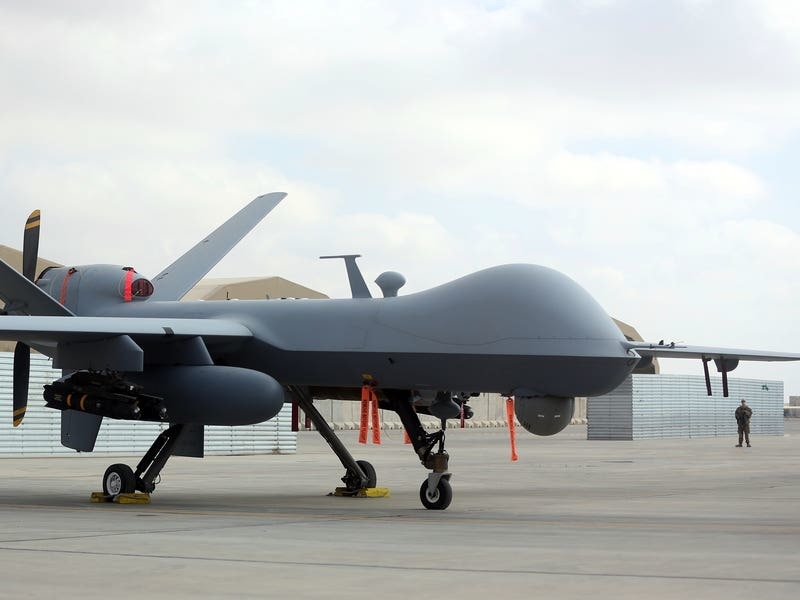When a Russian fighter jet collided with a large US surveillance drone over the Black Sea on Tuesday, it was a rare but serious incident that triggered a US diplomatic protest and raised concerns about the possibility Russia could recover sensitive technology.
US and Russian officials had conflicting accounts of the collision between the MQ-9 Reaper drone and the Russian Su-27 fighter jet – each blaming the other. But a Pentagon spokesman raised the possibility that the Defence Department could eventually declassify and release video it has of the collision.
Defence officials said the drone has not been recovered. But the Pentagon declined to say whether any effort was under way to gather debris or pieces of the Reaper.
Here is what is known – and uncertain – about the crash.
– What the US says happened
Two #Russian Su-27 aircraft conducted an unsafe & unprofessional intercept with a @usairforce intelligence, surveillance, & reconnaissance unmanned MQ-9 aircraft operating w/in international airspace over the #BlackSea today. https://t.co/nLuJy2Awbe@DeptofDefense @NATO pic.twitter.com/f0njn4gzSj
— U.S. European Command (@US_EUCOM) March 14, 2023
The Pentagon and US European Command said that two Russian Su-27 aircraft dumped fuel on the MQ-9, which was conducting a routine surveillance mission over the Black Sea in international airspace. They said the Russian jets flew around and in front of the drone several times for 30 to 40 minutes, and then one of the Russian aircraft “struck the propeller of the MQ-9, causing US forces to have to bring the MQ-9 down in international waters”.
Air Force General James Hecker, commander of US Air Forces Europe and Africa, said that the Russian jet’s actions “nearly caused both aircraft to crash”. Pentagon spokesman Brigadier General Pat Ryder said the collision probably also damaged the Russian fighter jet, but the Su-27 was able to land. He would not say where it landed.
The Pentagon said the drone was “well clear” of any Ukrainian territory, but did not provide details. A US defence official said it was operating west of Crimea over the Black Sea. The official spoke on condition of anonymity to provide mission details.
It is not clear if the collision was an accident or intentional, but both sides agree the Russian aircraft were trying to intercept the drone.
– What Russia says happened
Russia has declared broad areas near Crimea off limits to flights. Ever since the 2014 annexation of Crimea and long before Russia invaded Ukraine last year, Moscow has claimed that US surveillance planes were flying too close to its borders while ignoring the notices issued by Russia.
Nations routinely operate in international airspace and waters, and no country can claim limits on territory outside of its own border.
The ministry said the Russian aircraft were scrambled to intercept the drone but did not use weapons on it or impact it.
– What is an MQ-9 Reaper?
The MQ-9 Reaper is a large unmanned Air Force aircraft that is remotely operated by a two-person team. It includes a ground control station and satellite equipment and has a 66ft wingspan. The team includes a rated pilot who is responsible for flying the aircraft and an enlisted aircrew member who is charged with operating the sensors and guiding weapons.
The Reaper, which first began operating in 2007, replaced the Air Force’s smaller Predator drones. Each Reaper costs about 32 million dollars (£26 million).
– Diplomatic dust-up
The collision triggered a diplomatic protest.
The US State Department summoned Russian ambassador Anatoly Antonov to a meeting on Tuesday with Karen Donfried, the assistant secretary of state for Europe.
“We are engaging directly with the Russians, again at senior levels, to convey our strong objections to this unsafe, unprofessional intercept, which caused the downing of the unmanned US aircraft,” said State Department spokesman Ned Price.

Defence secretary Lloyd Austin had not talked to his Russian counterpart regarding the incident, Brig Gen Ryder said.
– Has it happened before?
It is not the first time Russian aircraft have flown so close to US aircraft in the Black Sea that it has prompted the Pentagon to publicly condemn the incident for putting the crews at risk. In 2020, Russian jets crossed in front of a B-52 bomber that was flying over the Black Sea, and flew as close as 100ft in front of the bomber’s nose, causing turbulence.
Russian jets have also buzzed US warships during exercises in the Black Sea. In 2021, Russian warplanes buzzed the USS Donald Cook, a Navy destroyer, which had been taking part in a major exercise. Until Russia’s invasion last year of Ukraine, US warships had established more frequent deployments to the Black Sea in response to Russia’s 2014 attack on Crimea.
For the most part, however, military intercepts – either in the air or at sea – are routine and have happened a number of times with Russian aircraft in the Pacific, particularly in the north. Just last month, US fighter jets intercepted two Russian TU-95 bombers in international airspace off Alaska’s coast, and “escorted them” for 12 minutes, according to the Pentagon.
And Russian aircraft have done similar missions, and also buzzed US Navy ships in the Pacific. In most of the cases, the intercepts are deemed safe and professional.
It is not clear if the Russian pilots were willing to get closer to the Reaper or dump fuel on it because they knew it was unmanned – and therefore there was no risk to an American pilot or crew. The deliberate downing of a manned aircraft – injuring or killing crew members – could be considered an act of war.






